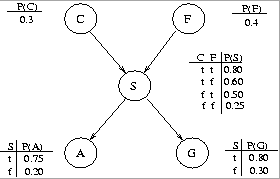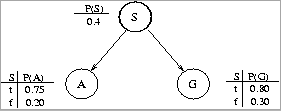
Our agent is hungry and unhappy, and wants to go on a vacation, sunbathe, and eat well. Our agent starts out rich, but only has limited options, some of which will consume a substantial part of its wealth.
| have(car) | The agent has a car | |
| distance(x,y,d) | The distance from x to y is d; distance is assumed to be reflexive; i.e., distance(x,y,d) <=> distance(y,x,d) | |
| temp(x,t) | The temperature at location x is t | |
| in(r,x) | Restaurant r is in city x | |
| beach(x) | There is a beach in location x | |
| fastfood(r) | r is a fast-food restaurant | |
| swanky(r) r is a swanky restaurant |
| at(x,s) | The agent is at x in situation s | |
| happy(s) | The agent is happy in situation s | |
| hungry(s) | The agent is hungry in situation s | |
| rich(s) | The agent is rich in situation s |
| Balt | Baltimore | |
| Berm | Bermuda | |
| OC | Ocean City | |
| McDs | McDonald's | |
| BK | Burger King | |
| CTC | Chez Tres Cher | |
| MC | Molto Caro |
(a) (7 pts.) Describe only the Happy predicate using the situation calculus. You should have one or more possibility axioms (one for each relevant action) and one or more successor-state axioms (one for each relevant action). These axioms should characterize how the state of the Happy predicate changes as a result of the actions in the domain, in terms of the domain predicates listed above. (You may want to refer to pages 330-333 in the book.)
(b) (7 pts.) Describe the actions in this domain as STRIPS operators. Be sure to include all preconditions, add lists, and delete lists. (See pages 377-378.)
(c) (5 pts.) Show two different legal plans (sequences of actions) for achieving the goal described above from the given initial state.
(d) (6 pts.) How many legal plans are there for this goal? Explain your
answer. Does the answer change depending on whether or not repeated
states are allowed?
Now suppose that the agent decides to satisfy its Happiness goal using
the Sunbathe action. Insert this action into the plan, showing all dependencies.
Will this plan succeed? If so, complete the partial plan, resolving any
threats that arise. If not, complete the partial plan to the point where
planning fails, and explain the source of the failure.

(a) (5 pts) Compute P(a, ~s, g) using the chain rule.
(b) (8 pts.) Compute P(a) using inference by enumeration.
(c) (9 pts.) Using conditional independence, compute P(~g, a | s) and P(~g, a | ~s). Then use Bayes' rule to compute P(s | ~g, a).(d) (5 pts.) The enterprising student notices that two types of
people drive SUVs: people from California (C) and people with large families
(F). After collecting some statistics, the student arrives at the BN:

Using the chain rule, compute the probability P(~g, a, s, c, ~f).
(e) (5 pts) Write, in summation form, the formula for computing
P(a, ~f) using inference by enumeration. (You do not need to
actually compute the probability.)
(f) (4 pts) What is the conditional independence assumption for a node in a BN?
(g) (4 pts) When are two variables conditionally independent of
each other in a BN?
(h) (10 pts) Using the rules for determining when two variables are (conditionally) independent of each other in a BN, answer the following (T/F) for the BN given in (c):